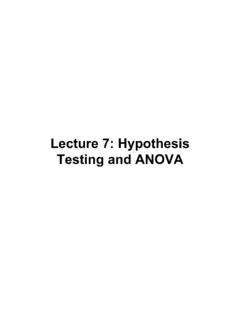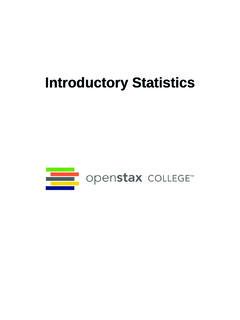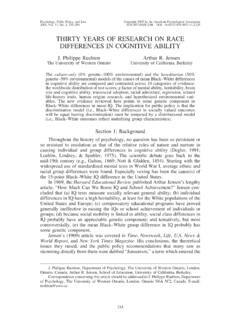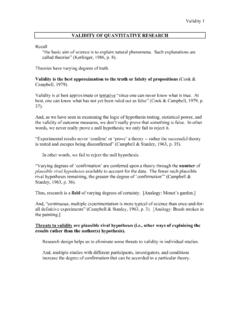Transcription of Inferential statistics - Duquesne University
1 Inferential statisticsWe ve seen how operational definition specifies the measurement operations thatdefine a variable. Last week we considered how carrying out such ameasurement operation assigns a number a score; a value to a one carries out not a single such operation of measurement butseveral and this gives us many scores: a distribution of ve seen how descriptive statistics can be used to describe such adistribution, in particular its central tendency and dispersion. (Notice that we re leaving to one side for a while notions of experimental designand hypothesis - testing . We ll return to these soon.)In addition to descriptive statistics , we need to understand inferentialstatistics : Inferential statistics provide a way of:going from a sample to a population inferring the parameters of a population from data on the statistics ofa , parameters such as m and s, from statistics such as m and before we can see what is involved in the move from sample to populationwe need to understand how to move from population to study of obtaining a sample from a population is probability.
2 Probability probability Population Samplefl Inferential statisticsfl For example: The probability of picking a black ball from jar A is one half; theprobability of picking a black ball from jar B is one tenth. [This is reasoning aboutprobability.]jar A:50 black,50 whitejar B:90 black,10 white [We would use Inferential statistics to answer questions such as: from which jaris one more likely to get a sample of four black balls?]Definition:the probability of an outcome B = number of outcomes classified as Btotal number of possible outcomesThis is written P(B)this is a proportion, a fraction 1 And a value of P(B) = 0 means the outcome is impossible;the value P(B) = 1 means the outcome is , for this definition of probability to be accurate, the outcomes must beselected randomly.
3 Definition: Random sample:1. every selection has an equal chance.( there is no bias to the selection)2. when there is more than one selection, there must be a constantprobability each time.( , we must be sampling with replacement )..or else we ll have a situation like this after we ve made our first selection:jar A:50 black,50 whitejar A:49 black;50 whiteNotice: random does not mean chaotic. Rather, random means there is a pattern that becomes apparent only when weexamine a large number of events. It means there is a pattern that doesn t showitself in a single case, or a few is the study of the patterns of random Normal DistributionThe kind of pattern that emerges from many types of random process is thenormal distribution See pattern emerging from a random process in a quincunx at: There s another at: the history of how Francis Galton invented the quincunx at: normal distribution is easily [We ll add this in class]Now we re ready for: Inferential StatisticsIt is usually necessary for a researcher to work with samples rather than a one difficulty is that a sample is generally not identical to thepopulation from which it , the sample mean will differ from the population mean.
4 X mand another difficulty is that no two samples are the same. How can weknow which best describes the population?We need rules that relate samples to populations The Distribution of Sample Means Definition: the distribution of sample means is the collection of sample meansfor all the possible random samples of a particular size (n) that can beobtained from a is not a distribution of scores, but a distribution of distribution tends to be will be almost perfectly normal if either:1. the population from which the sample is drawn is normal,or2. the n of the sample is relatively large (30 or more).This distribution has a mean that is equal to the population mean; m X = mand a standard deviation, s X , which is called the standard error of X.
5 The standard error is a very valuable measure. It specifies how well a samplemean estimates the population mean; how accurate an estimate a sample provides; , the error between X and m, on NOTE: It can be shown that: s X = s/ formula shows how it is that the accuracy of the estimate provided by asample increases as the sample size increases. (This formula and a related onewe ll introduce shortly is something APA says one needs to know for thelicensing exam.)Now we can turn TestingDefinition: hypothesis testing is an Inferential procedure that uses sample datato evaluate the credibility of a hypothesis about a hypothesis (H0): the treatment has no , the experimental group and the control group are drawn from thesame will seem confusing, since a good experiment assigns subjectsrandomly to the two groups.
6 The point here is that the nullhypothesis asserts that it is still the case AFTER THETREATMENT that the two groups belong to the same , on the other hand, the treatment did have an effect which ofcourse means that the null hypothesis is false then the two groupswould now come from different populations. Comprendas? , X expt and X control will not differ by more than random ,they will not differ by more than the standard error. How do we know the standard error? Remember, it s the standard deviation ofthe distribution of sampling means. Actually, we don t know it directly. But wecan estimate it: our estimate replaces the population parameter s with thesample statistic, s:Remember we said that it can be shown that s X = s/ the same way.
7 S X = s/ use the symbol s X indicate that the value is calculated from sampledata, rather than from the population we can say, if the null hypothesis is true, the experimental groupmean minus the control group mean will equal the estimated standarderror, or , If H0 is true, X expt minus X control s X , X expt minus X control / s X 1 (simply rearranging the formula)The left hand side of this equation is called t , the , if the null hypothesis is true, t 1 Conversely, if the null hypothesis is false, t > 1 How much greater than 1 will t be? We just calculate that from our data. Thenwe use this value to look in a table of t. This table will tell us how likely it is thatwe could have obtained our data as a result of chance alone.
8 That s to say, it tellsus the probability of the null hypothesis being true, given our data. That means,it tells us how confident we can feel in eliminating the null hypothesis . In otherwords, it gives us a p value!=== , the above stuff assumes:1. random sampling2. that the experimental treatment doesn t change s. ( , that it onlychanges m. This is the assumption of homogeneity of variance. )3. that the distribution of sampling means is normal. (We considered thisearlier.)




